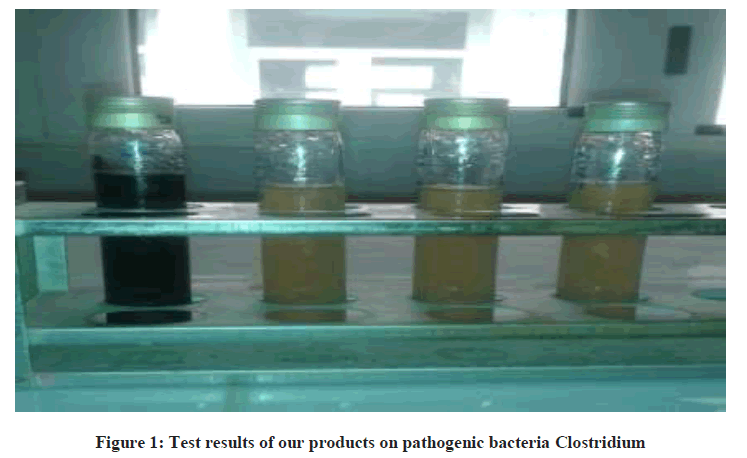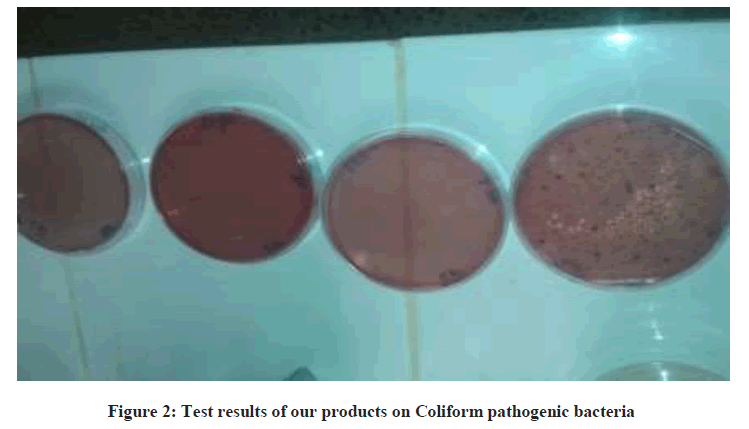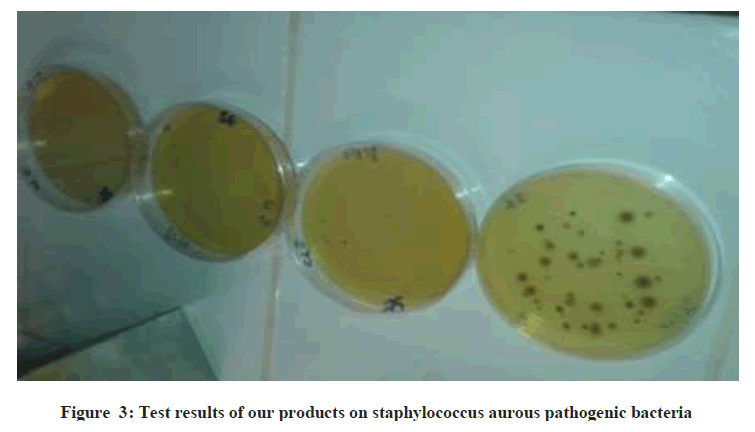Research Article - Der Pharma Chemica ( 2018) Volume 10, Issue 5
Synthesis of Antibiotics Effective Against Pathogenic Bacteria by the Use of Catalysts Porous Materials (H-Clay)
Elmeliani M’hammed1*, Djafri Fatiha1, Djafri Yada2, Dihmanabdelghani3 and Arboui Iliace4
1Department of Chemistry, Faculty of Exact and Applied Sciences, Laboratory of Chemistry of Materials, Oran University, Ahmed Ben Bella Algeria
2Department of Chemistry, Faculty of Exact and Applied Sciences, Applied Organic Synthesis Laboratory, Oran University, Ahmed Ben Bella Algeria
3The Quality Control Laboratory of Wilaya of Adrar - Algeria
4Department of Physics, Faculty of Exact and Applied Sciences, Laboratory of Sciences of the Environment and Materials, Oran University, Ahmed Ben Bella Algeria
- *Corresponding Author:
- Elmeliani M’hammed
Department of Chemistry
Faculty of Exact and Applied Sciences
Laboratory of Chemistry of Materials
Oran University, Ahmed Ben Bella Algeria
Abstract
The study carried out is related to the synthesis of antibiotics, which are effective against the pathogenic bacteria using porous materials catalysts. Effective addition of amines to a series of α, β-unsaturated alkenes was performed by using the H-Clay catalyst to synthesize effective antibiotics in order to destroy or stop the growth of pathogenic bacteria. The operation was carried out in extremely appropriate conditions: ambient temperature, solvent-free, and green catalyst environmentally friendly, so the products that are synthesized give very high yields against pathogenic bacteria and excellent chemo-selectivity.
Keywords
Porous materials, H-clay, Amines, Bacteria, Environment, Pathogenic
Introduction
Porous materials [1-5] are materials with a huge number of cavities; it is produced in a vast area per unit volume, so these materials are metastable. The porous materials are classified into different categories, depending on the size of their porous micro porous materials [6,7], materials with pores less than 2 nm in size, macro porous solids whose pores are more than 50 nm, and materials of the intermediate category are called meso porous materials [8]. Clay is part of micro porous materials.
Clays [9-15] are crystalline porous materials we can be use them in many separation processes; to extract oxygen from the air or to separate the ortho, meta and para isomers of xylene from a mixture. The adsorption selectivity properties of the molecules are exploited in these molecular sieves. Clays are also among the polides used in the industrial field and in catalysts [16]. They are used in different fields such as industry, sanitary, environment, etc. These polides are used in heterogeneous catalysis; the modification of these polides for metals can improve their physicochemical properties.
The design and the synthesis of clay [17-19] with the appropriate physicochemical properties for its application [20] in an industrial chemical process must be rationalized taking inconsideration both both of the scientific requirements and the overall economic cost of its manufacture. The direct synthesis [21] of functional micro porous materials would offer precious advantages over multi-stage preparations, for example, significant savings that can be achieved by the reduction of the number of steps required for catalyst synthesis [22-23]. Controlling variables that rule and direct synthesis to micro porous material with custom properties is a so difficult and it’s industrially a relevant task.
In recent years, great efforts have been done for the direct preparation of molecular sieves with more improved and modified specific functionalities. Having new materials new materials with extraordinary and unique properties has become possible.
Developing new synthetic methodologies [24] for the preparation of these compounds is an interesting area of research in synthetic organic chemistry. The use of heterogeneous catalysts for organic conversion is growing rapidly on homogeneous catalyst systems due to several advantages of heterogeneous catalysts such as high stability, ease of handling, recovery and reuse, non-corrosive character, long-lasting persistent catalytic activity and respect of the environment [25].
Actually, several clay catalyzed organic transformations are reported, a solid support acid catalyst [26] is very cheap, easy to prepare in the laboratory and can be stored for a long time without significant loss of catalytic activity.
The main objective of our study is synthesizes antibiotics effective against pathogenic bacteria using an H-clay catalyst (Table 1) [27-30], we based on one hand on the addition AZa- Michael [31-35], amines on α, β-unsaturated compounds, catalyzed by H-Clay [36], and on the other hand on the development of clean and economic methods [37-39], thereafter we switched to biologic activity of our products on pathogenic bacteria [40-44], we finally got very interesting results.
| Entry | Alkenes | Amines | Product | Time (min) | Yield (%) | Catalyst |
|---|---|---|---|---|---|---|
| 1 |  |
 |
 |
20 | 95 | H-Clay |
| 2 |  |
 |
 |
10 | 97 | H-Clay |
| 3 |  |
 |
 |
20 | 96 | H-Clay |
Table 1: Antibiotic products synthesized by the catalyst (H-clay)
Materials and Methods
As part of the synthesis of antibiotics effective against pathogenic bacteria [45,46] by using porous catalysts materials, we chose by the following approaches:
Firstly, we adopted a strategy for our realization of organic synthesis; it would be respectful of the environment, called green, according to the following chemical reaction (Scheme 1):
Secondly, we passed tests of biological activity; this step was carried out in a laboratory of quality control.
The microbiology tests of our products have been performed on chicken rot meat (already contaminated with pathogenic bacteria), Staphylococcus aurous, Coliform, and Clostridium, which are known in the field of quality control or medicine. This step needed only simple materials; boxes of kneading’s, test tubes-graduated flasks, pipette pastors, graduated pipettes, and culture media for each bacterium. We divided our biological activity test into two sub steps: sample preparation and seeding.
Biological activity
First step (sample preparation)
10 g of chicken meat was put in 90 ml of TSE (Try tone-sell-water) specific diluents in four (4) flasks, one of these flasks considered as a control, without any added product, after adding to each 3 vials 1 ml of our products 1, 2, 3, after agitating the mixture laying two (02) minutes, so 04 different samples would be produced.
Second stage (seeding)
After 30 minutes, we proceed to seeding (the culture of the bacteria in the dishes with the specific culture medium for each type bacteria) After having prepared the four samples, microbiological analyzes are carried out for each different sample that is to say, each type of bacterium sought to undergo the test of the three products R1, R2, R3.
The kneaded dishes must be incubated in an oven at a time and temperature defined according to the bacterium sought for growth (parboiling).
Results and Discussion
The Figures 1-3, show the results of tests of the biological activity of our products on rotten chicken meat, Staphylococcus aurous, Coliform, and Clostridium. Signing, these results were obtained after 72 hours of parboiling.
According to the results, we found and which are represented in Figures 2 and 3. We found that the box reference or control contains too many bacteria, but no traces of bacteria (Null), in the three boxes that contain the samples with our products R1, R2, R3. The results obtained show that: - Our products are excellent antibiotics and effective for destroying or blocking pathogenic bacterial growth. In the same context and after the completion of the biological tests; It has been observed that an excellent yield and better products like antibiotics is obtained by the addition of aza-Michael by reacting a mixture (1.2 equivalents) of amines on (1.0 equivalents) of alkenes in the presence of H-clay: (100 mg) as catalyst, at room temperature, and the reaction without solvent.
The addition of primary amines gave only monoalkyl products, [10] no secondary products were observed using excess amines. The pure product can be obtained by removing the catalyst by filtration [11] and then removing the excess amines by a rotary evaporator. The recovered catalyst was reactivated and reused several times for three other aza-Michael reactions; the products gave excellent yield (92-98) after (10-23) minutes. The products have been characterized by 1H-NMR spectroscopy.
Conclusion
From all results obtained in this study, we concluded that the use of H-clay materials for synthesizing antibiotics is important by the addition of amines to alkenes, and these antibiotics have significant efficacy. They can destroy or block bacterial growth. The use of inexpensive, reusable H-clay catalyst, and solvent-free reaction, short time, excellent chemo selectivity, high yield, and easy purification of products, are the main features of this elegant protocol. Therefore, these results allowed us to say that our H-clay catalyst is very effective in achieving the goal, and the development of aza-Michael addition.
Spectral data
Product 1
RF= 0.60 (Hexane-EtoAc): 2/1
1H-NMR (CDCl3, 300 MHz) δ: 0.8-1.06 (m, 16H); 1.06-2[(m, 1H) ;( q, 1H) ;( t, 3H)]; 2.60 (m, 1H); 2.77-2.81 [(q, 4H); (q, 2H)]
Product 2
RF= 0.10 (Hexane-EtoAc): 2/1
1H-NMR (CDCl3, 300 MHz) δ: 0.8-1.02 (m, 9H); 1.02-1.05 (q, 6H); 1.06 (m, 1H); 2.0 (m, 1H); 2.6 (q, 1H); 3.5 (s, 1H); 4.0 (s, 1H); 6.6 - 6.7 (d, 2H); 6.9 (dd, 1H); 7.17 (dd, 2H)
Product 3
RF= 0.10 (Hexane-EtoAc): 2/1
1H-NMR (CDCl3, 300 MHz) δ: 0.9 (m, 9H) ; 1.01 (t, 6H) ; 1.25 (q, 2H) ; 1.40 (q, 4H) ; 1.70 (m, 1H) ; 2.0 (m, 2H) ; 2.59 -2.60 (q, 5H) ; 3.50 (t, 2H) ; 4.0 (s, 1H) ; 6.60 (t, 1H); 6.70 (d, 2H).
References
- J. Rouquerol, D. Avnir, C.W. Fairbridge, D.H. Everett, J.H. Haynes, N. Pernicone, J.D.F. Ramsay, K.S. W. Sing, K.K. Unger, Pure and Applied Chemistry., 1994, 668, 1739-1758.
- G. Férey, Chemical News., 2007, 304, 3-15.
- C.T. Kresge, Nature., 1992, 359, 710-712.
- J.S. Beck, J. Am. Chem. Soc., 1992, 114, 10834-10843.
- F. Hoffmann, M. Fröba, Chem. Soc. Rev., 2011, 40, 608-620.
- Y. Zhang, I.J. Drake, A.T. Bell, Chem. Mater., 2006, 18,2347-2356.
- A.C.R. Acad. Sci. Paris, Hc, Chimie/Chemistry, 2000, 3(2010), 541-551.
- J. Wood, Materials Today., 2007, 11, 40-45.
- M.F. Aldersley, P.C. Joshi, J.D. Price, J.P. Ferris, Applied Clay Science., 2011, 54(1), 1-14.
- J. Allègre. Alumina silicates (clays) in therapy a customary practice ancient relays in modern medicine, medical thesis, publicly supported in Bobigny, December 19th, 2012.
- N.C. Amin, Y.Y.J. Andji, M. Aké, S.F. Yolou, Abba A. Touré, Gabrielle Kra, J. Sci. Pharm. Biol., 2009, 10(1), 21-30.
- M.Y. Brouillard, J.G. Rateau, Gastroenterology. Cline. Biol., 1989, 13, 18-24.
- M.I. Carretero, Applied Clay Science., 2002, 21, 155-163.
- M.I. Carretero, M. Pozo, Applied Clay Science., 2009, 46, 73-80.
- P. Chavanne, Clay Remedies, First Editions, Legal Deposit, 2011.
- J. Choy, S. Choi, J. Oh, T. Park, Applied Clay Science., 2007, 36, 122-132.
- S.T. Belt, W.G. Allard, J. Rintatalo, L.A. Johns, A.C.T. Van Dun, S.J. Rowland, Geochim. Cosmochim. Acta., 2000, 64, 3337-3345.
- V.R. Choudhary, R. Jha, V.S. Narkhede, J. Mol. Catal. A Chem., 2005, 239, 76-81.
- H.A. Dabbagh, A. Teimouri, A.N. Chermahini, Appl. Catal., 2007, 76, 24-33.
- G. Nagendrappa, Applied Clay Science., 2011, 53, 106-138.
- M.R. Dintzner, K.M. Morse, K.M. Mc Clelland, D.M. Coligado, Tetrahedron Lett., 2004, 45, 79-81.
- A.M. Ehsan, S. Ehsan, S. Khan, M.S. Khan, J. Chem. Soc. Pak., 2006, 28, 489-493.
- Z. Gültekin, Clay Miner., 2004, 39, 345-348.
- M.K. Hazarika, R. Parajuli, Indian J. Chem. Technol., 2007, 14, 104-106.
- P.R. Singh, M.P. Surpur, S.B. Patil, Tetrahedron Lett., 2008, 49, 3335-3340.
- C.R. Reddy, G. Nagendrappa, B.S. Jai Prakash, Catal. Commun., 2007, 8, 241-246.
- S.B. Neji, J. Soc. Chim. Tunisie., 2009 11, 191-203.
- Y. Liu, E. Lotero, J.G. Goodwin, J. Catal., 2006, 243, 221.
- D. Habibi, O. Marvi, Catal., 2007, 8, 127.
- M. Choel, K. Deboudt, J. Osan, P. Flament, R.V. Grieken, Anal. Chem., 2005, 77, 5686.
- C. Mukherjee, A.K. Misra, Lett. Org Chem., 2007, 4, 54-59.
- N. Azizi, M.R. Saidi, Tetrahedron., 2004,60, 383-387.
- B.M. Reddy, M.K. Patil, B.T. Reddy, Catal Lett., 2008, 126, 413-418.
- Y. Wang, Y.Q. Yuan, S. Rong, Molecules.,2009, 14, 4779-4789.
- J. Nath, M.K. Chaudhuri, Catal. Lett., 2009,133, 388-393.
- N. Besbes, H. Jellali, M.L. Efritb, Srasraj, Soc. Alger. Chim., 2016, 20(1), 1-71.
- Y. Lei, X. Chungu, H.H. Chin, J. Catal., 32, 2011, 1573-1576.
- N. Azizi, R. Baghi, H. Ghafuri, M. Boloutchian, M. Hashemi, Synlett., 2010, 379-382.
- D.M. Pore, M.S. Soudagar, U.V. Desai, T.S. Thopate, P.P. Wadagaonka, Tetrahedron Lett., 2006, 47, 9385-9328.
- L.H. Taylor, S.M. Latham, M.E.J. woolhouse, Phil. Trans. R. Soc. Lond. B., 2001, 356, 983-989.
- M.W. Hahn, H. Lunsdorf, Q. Wu, M. Schauer, M.G. Hofle, J. Boenigk, P. Stadtler, Appl. Environ. Microbiol., 2003, 69, 1442-1451.
- H. Schulz, B. Jorgensen, Annu. Rev. Microbiol., 2001, 55, 105-137.
- J. Mansfield, S. Genin, S. Magori, V. Citovsky, M. Sriariyanum, P. Ronald, M. Dow, V. Verdier, S.V. Beer, M.A. Machado, I. Toth, G. Salmond, G.D. Foster, Molecular. Plant. Pathology., 2012, 13(6), 614-629.
- G.M. Weinstock, Nature., 2012, 489, 250-257.
- L. Alibaud, T. Kohler, A. Coudray, C. Prigent-Combaret, E. Bergeret, J. Perrin, M. Benghezal, C. Reimmann, Y. Gauthier, C. van Delden, I. Attree, M.O. Fauvarque, P. Cosson, Cell Microbiol., 2008, 10(3), 729-740.
- R. Froquet, N. Cherix, S.E. Burr, J. Frey, S. Vilches, J.M. Tomas, P. Cosson, Appl. Environ. Microbiol., 2007, 73(17), 5657-5659.







